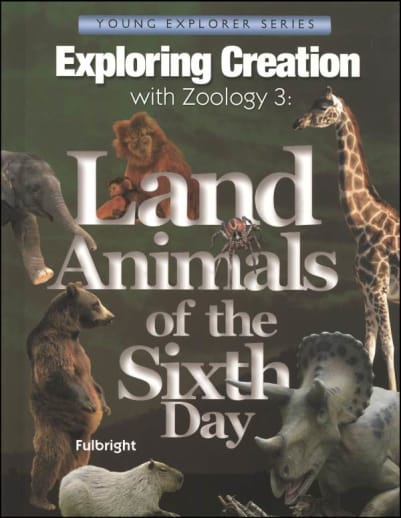This is it, the eagerly anticipated and finally available third book in the"Exploring Creation with Zoology" series. Now it's time to learn about all the land animals God created on the sixth day. Animals in this category are diverse and include many different types. Like the others in this series, the groups are studied using their scientific names. You'll learn about Carnivores, Caniforms, Feliforms, Marsupials, Primates, Rodentia, Ungulates (hoofed animals), Artiodactyla, reptiles, amphibians, and even dinosaurs. The book is divided into 14 modules, each containing the quality information and illustrations you've come to expect from Apologia. Children will learn about what makes each group very special and different from other groups of animals.At the end of each module, children will engage in a variety of notebookactivities and experiments. A "Track It!" activity helps students identify tracks of the animals just covered in that module. The "Map It!" activity encourages students to mark a map with the location of where you might find the animals from that module. How Exciting! I think parents will really enjoy learning along with their children about the unique land creatures God created.
Exploring Creation with Zoology 3: Land Animals of the Sixth Day
Description
What separates people from apes? How can a Great Dane be related to a Chihuahua? Is there evidence that people and dinosaurs lived at the same time? What should you do if you encounter a bear? How can you tell if a snake is poisonous? Come find out answers to these questions and many, many more with Apologias Exploring Creation with Zoology 3! This third book in the zoology series takes students on a safari through jungles, deserts, forests, farms, and even their own backyard to explore, examine and enjoy the enchanting creatures God designed to inhabit the terrain. Families will snuggle together and discover the amazing animals from primates to parasites, kangaroos to caimans, and turtles to terrifying T-Rexs this safari doesnt end there! Students will also keep a record of where each animal is found on a map and learn to identify animal tracks. As with all the Apologia elementary books, students will continue the practice of narration, keeping a notebook of what they have learned, and enjoy many hands on projects and experiments throughout the course.
Apologia Science courses are written from a Biblical worldview with the homeschool in mind. At the elementary level, courses follow a Charlotte Mason-inspired methodology, with lessons organized around narration, notebooking exercises and hands-on activities or projects. Children at different ages can use these together, learning at their own level. Each course is designed to be teacher-student interactive, so teacher involvement is fairly high at this level. At the junior high and high school levels, science courses are more traditional in nature, with the textbook written to the student. Teacher involvement time at this level is much less than at the elementary level. Textbooks contain student reading, lab instructions, "On Your Own" questions and Study Guide questions. A Solutions Manual provides the answers to these and the test questions. Lab kits are available separately for both the elementary and upper-level science courses which include most of the harder to find items you will need.
| Product Format: | Hardcover |
|---|---|
| Grades: | K-6 |
| Brand: | Apologia |
| ISBN: | 9781932012859 |
| Length in Inches: | 11.25 |
| Width in Inches: | 8.75 |
| Height in Inches: | 0.75 |
| Weight in Pounds: | 2.375 |

